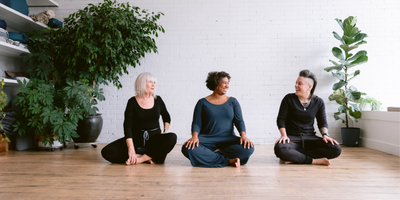Final Resting Pose - Corpse Pose for Bedtime
Should you sleep in corpse pose?
How do you feel when you wake up in the morning? If you wake up with a sore back, neck, or shoulders or with pins & needles in your hands or feet, maybe you should re-consider your preferred sleeping position.
It's well known that the best position for most of us to sleep in is on our backs. But have you thought about the position of the rest of your body? If you sleep with your knees bent or with your arms above your head, you may be doing yourself a disservice.
Consider the importance of extending your limbs during slumber.
The majority of us spend most of our day sitting. We move from the breakfast table to our car to our desk back to our car, the dinner table then the couch. In a seated position, our hips, knees and elbows are generally in flexion putting a strain on the muscles surrounding these joints. If we go to sleep with the body in a similar curled up position, eventually the body will be too tight to fully open or we can create impingements in our joints.
Bedtime is an opportunity for the body to reset and realign.
Sleeping on your back makes it easy for your head, neck, and spine to maintain a neutral position so your muscles and tissues can relax evenly in all directions.
We can extend this same principle to our extremities by sleeping in savasana position.
Lie on your back and let your arms and legs fall equally from the mid-line of your body. Allow space between the upper arms and torso. Let the legs & feet naturally fall open. Turn your palms face up to set your shoulder blades into your back and tuck your chin lightly towards your chest to lengthen the back of your neck. Now the shoulder, elbow and knee joints will maintain a neutral position.
Taking savasana at bedtime can also help reduce symptoms of carpal tunnel.
CTS symptoms often come on at night and may wake you up. Some doctors believe this is because the fluid in the body is redistributed when you lie down, so more of it accumulates in the wrist. But another contributing factor may be your sleeping position: You may sleep with your wrists bent and/or tucked under your head or pillow, which can cause compression of the median nerve. So when you settle down for the night, allow your hands or wrists to lie flat on the mattress. (info found here)
Try adding small hand weights to keep your arms and hands still while you sleep.

Still can’t get comfortable in Savasana?
For many people it is helpful to add a pillow or bolster under your knees to take any pressure off the sciatic nerve.
Try a soothing eye pillow scented with lavender to allow the muscles in the face to soften and calm the mind.

Need more reasons to sleep in corpse pose?
- It's also ideal for fighting acid reflux, says Eric Olson, M.D., co-director of the Mayo Clinic Center for Sleep Medicine in Rochester, Minnesota: "If the head is elevated, your stomach will be below your esophagus so acid or food can't come back up."
- Back-sleeping also helps prevent wrinkles, because nothing is pushing against your face, notes Dee Anna Glaser, M.D., a professor of dermatology at Saint Louis University.
- Sleeping on your back balances out your body weight and keeps internal organs aligned.
Props for a better sleep





